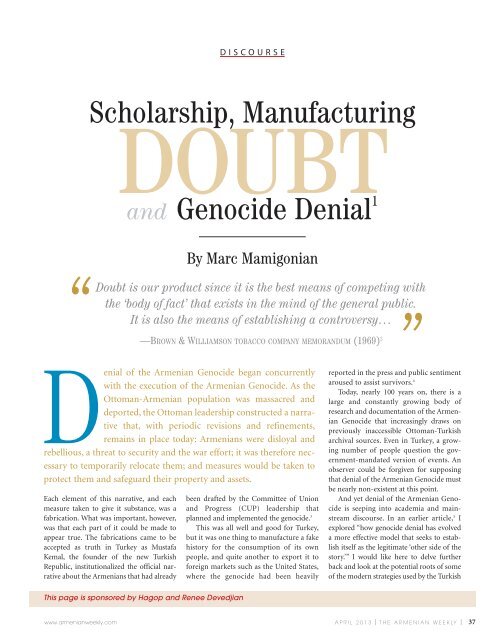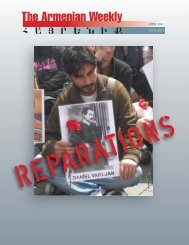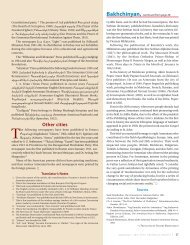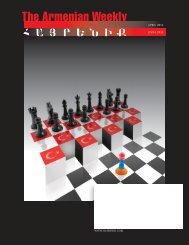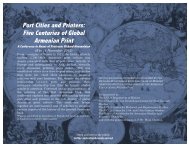Create successful ePaper yourself
Turn your PDF publications into a flip-book with our unique Google optimized e-Paper software.
DISCOURSE<br />
Scholarship, Manufacturing<br />
DOUBT<br />
and Genocide Denial 1<br />
By Marc Mamigonian<br />
“<br />
Doubt is our product since it is the best means of competing with<br />
the ‘body of fact’ that exists in the mind of the general public.<br />
It is also the means of establishing a controversy. . .<br />
”<br />
—BROWN & WILLIAMSON TOBACCO COMPANY MEMORANDUM (1969) 2<br />
Denial of the <strong>Armenian</strong> Genocide began concurrently<br />
with the execution of the <strong>Armenian</strong> Genocide. As the<br />
Ottoman-<strong>Armenian</strong> population was massacred and<br />
deported, the Ottoman leadership constructed a narrative<br />
that, with periodic revisions and refinements,<br />
remains in place today: <strong>Armenian</strong>s were disloyal and<br />
rebellious, a threat to security and the war effort; it was t<strong>here</strong>fore necessary<br />
to temporarily relocate them; and measures would be taken to<br />
protect them and safeguard their property and assets.<br />
Each element of this narrative, and each<br />
measure taken to give it substance, was a<br />
fabrication. What was important, however,<br />
was that each part of it could be made to<br />
appear true. The fabrications came to be<br />
accepted as truth in Turkey as Mustafa<br />
Kemal, the founder of the new Turkish<br />
Republic, institutionalized the official narrative<br />
about the <strong>Armenian</strong>s that had already<br />
been drafted by the Committee of Union<br />
and Progress (CUP) leadership that<br />
planned and implemented the genocide. 3<br />
This was all well and good for Turkey,<br />
but it was one thing to manufacture a fake<br />
history for the consumption of its own<br />
people, and quite another to export it to<br />
foreign markets such as the United States,<br />
w<strong>here</strong> the genocide had been heavily<br />
reported in the press and public sentiment<br />
aroused to assist survivors. 4<br />
Today, nearly 100 years on, t<strong>here</strong> is a<br />
large and constantly growing body of<br />
research and documentation of the Armen -<br />
ian Genocide that increasingly draws on<br />
previously inaccessible Ottoman-Turkish<br />
archival sources. Even in Turkey, a growing<br />
number of people question the government-mandated<br />
version of events. An<br />
observer could be forgiven for supposing<br />
that denial of the <strong>Armenian</strong> Genocide must<br />
be nearly non-existent at this point.<br />
And yet denial of the <strong>Armenian</strong> Geno -<br />
cide is seeping into academia and mainstream<br />
discourse. In an earlier article, 5 I<br />
explored “how genocide denial has evolved<br />
a more effective model that seeks to establish<br />
itself as the legitimate ‘other side of the<br />
story.’” I would like <strong>here</strong> to delve further<br />
back and look at the potential roots of some<br />
of the modern strategies used by the Turkish<br />
This page is sponsored by Hagop and Renee Devedjian<br />
www.armenianweekly.com<br />
APRIL 2013 | THE ARMENIAN WEEKLY |<br />
37


